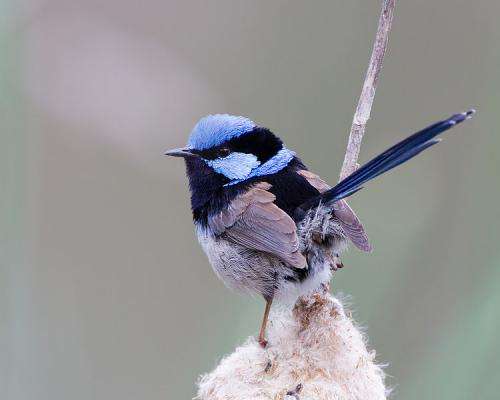June 13, 2013 report
Study shows fairy-wrens learn to drive off cuckoos from their neighbors

(Phys.org) —William Feeney and Naomi Langmore, researchers with Australia's Research School of Biology, have found that fairy-wrens learn to distrust cuckoos by watching other nearby fairy-wrens react to them. In their paper published in the journal Biology Letters describing a field study involving the use of a stuffed bird, the researchers noted changes in behavior by fairy-wrens after learning to distrust cuckoos.
Cuckoos are known as brood parasites—they lay their eggs in the nests of other birds rather than building their own. This frees them from the burden of having to raise and protect them. Before depositing an egg in a nest, the cuckoo will push one of the existing eggs out so the number of eggs doesn't change. The cuckoo egg also looks like the other eggs in the next, so the bird doing the brooding is none the wiser. The cuckoo in the egg hatches earlier than the other birds in the nest and to give itself a better chance of surviving, heaves the other eggs out of the nest. Then, because as a chick it looks like the chicks of the host nest, the host mother feeds and raises it.
One type of host bird is the fairy-wren—cuckoos are notorious for trying to trick them into raising their young for them. But fairy-wrens are apparently not complete suckers. Feeney and Langmore have found that over time they learn to drive off cuckoos by watching how other fairy-wrens react to them.
The two researchers got the idea to study the fairy-wren because prior research had found that some of the birds drive off cuckoos instead of falling prey to their scam. How they learned to do so was a mystery.
To find out, the researchers employed the use of a stuffed cuckoo. They placed it in a location where newly adult fairy-wrens would see it. As expected, none of them reacted adversely. Next, they placed the stuffed cuckoo in an area where older fairy-wrens congregated with younger "naïve" birds. The older birds reacted by trying to drive the cuckoo away. A short time later, the researchers then placed the same stuffed cuckoo near the naive birds after they had witnessed the behavior of the older, wiser birds. They proceeded to drive off the cuckoo as well, clearly having learned from the other birds that had themselves either learned firsthand of the scam conducted by cuckoos or by watching older birds react to them.
More information: William E. Feeney and Naomi E. Langmore, Social learning of a brood parasite by its host, Biol. Lett. August 23, 2013 9 4 20130443; doi:10.1098/rsbl.2013.0443 1744-957X rsbl.royalsocietypublishing.or … content/9/4/20130443
Abstract
Arms races between brood parasites and their hosts provide model systems for studying the evolutionary repercussions of species interactions. However, how naive hosts identify brood parasites as enemies remains poorly understood, despite its ecological and evolutionary significance. Here, we investigate whether young, cuckoo-naive superb fairy-wrens, Malurus cyaneus, can learn to recognize cuckoos as a threat through social transmission of information. Naive individuals were initially unresponsive to a cuckoo specimen, but after observing conspecifics mob a cuckoo, they made more whining and mobbing alarm calls, and spent more time physically mobbing the cuckoo. This is the first direct evidence that naive hosts can learn to identify brood parasites as enemies via social learning.
Journal information: Biology Letters
© 2013 Phys.org




















